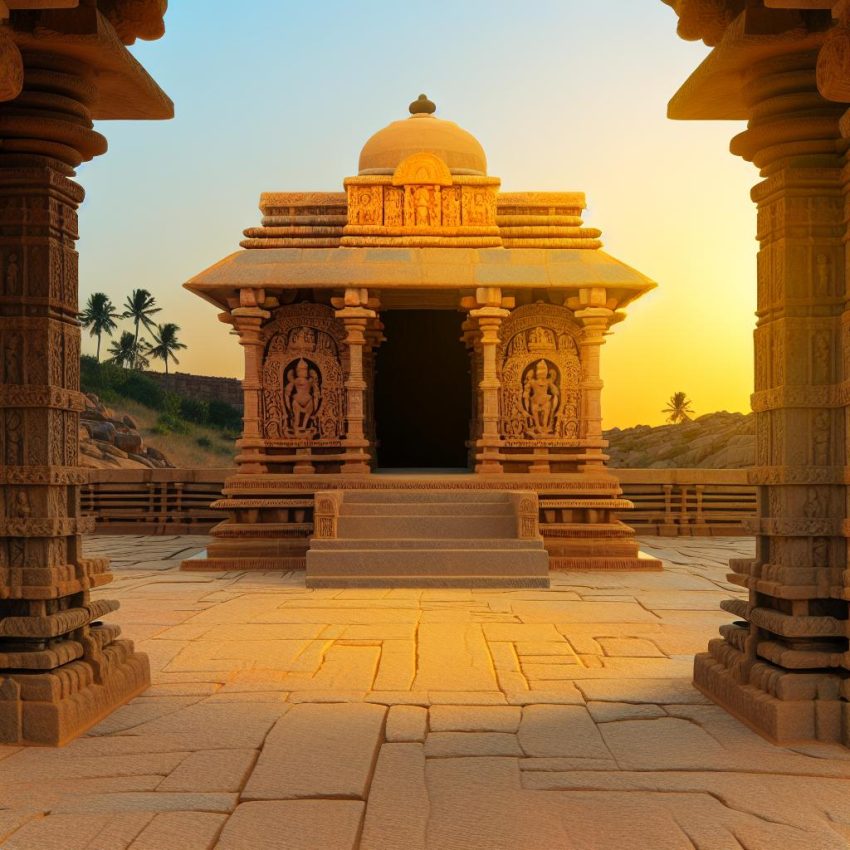Overview of Banashankari Temple, Badami
The Banashankari Temple, nestled in the historic town of Badami in the state of Karnataka, India, stands as a testament to both spiritual devotion and architectural ingenuity. This temple, dedicated to Banashankari Devi, a manifestation of the goddess Parvati, is not only a place of worship but also an emblem of the region’s rich cultural history. Established in the 7th century by the influential Chalukyan dynasty, this temple encapsulates an era characterized by artistic accomplishment and religious fervor.
Architectural Significance
The Banashankari Temple is celebrated for its architectural significance, reflecting the artistic excellence of the Chaluka period. The temple complex exhibits Dravidian-style architecture, a style known for its grandeur and intricate detailing. This architectural style can be recognized by its towering temple spires, known as Vimana, and the exquisite carvings adorning the temple walls. These carvings often depict mythological tales, celestial beings, and intricate geometric patterns, making the temple a visual feast for visitors.
One of the most captivating aspects of the temple is its distinct square-shaped water tank, referred to as “Haridra Tirtha.” This tank holds religious importance and serves as a focal point within the temple complex. The calm, reflective waters of the tank are surrounded by steps on all sides, allowing devotees and visitors to descend close to the water, which is deemed sacred. The presence of such water bodies is a common feature in South Indian temples, enhancing both the aesthetic and spiritual ambiance of the site.
The Deity
Central to the temple’s appeal is the presiding deity, Banashankari Devi. This revered goddess is regarded as an embodiment of might and benevolence, worshiped by those seeking protection and guidance. The idol of Banashankari Devi is a powerful image, portraying the goddess seated upon a lion, a symbol of courage and authority. Beneath her feet lies a demon, signifying her triumph over malevolence and chaos. This representation underscores the goddess’s role as both a protector and a nurturer, drawing devotees who seek her blessings for both personal and communal well-being.
Festivals and Celebrations
The temple is not only a destination for worship but also a hub of vibrant cultural festivities. Among the various celebrations, the Banashankari Jatre stands out as a major event on the temple’s calendar. Taking place in the months of January or February, this festival is a grand affair that attracts a large congregation of devotees and tourists alike. The festival is a colorful amalgamation of religious, cultural, and social activities. Attendees immerse themselves in the festive spirit, participating in special rituals and poojas conducted during this time.
In addition to religious ceremonies, the festival features a bustling fair. This fair is a showcase of the region’s cultural diversity, offering a range of attractions such as traditional crafts, local delicacies, and cultural programs. It’s an opportunity for visitors to interact with the local community, gaining insights into their customs and traditions. The fair also serves as a platform for artisans and vendors, promoting the local handicrafts and culinary specialties of Karnataka.
Visiting Badami
The allure of the Banashankari Temple extends beyond its sacred walls. The town of Badami itself is a treasure trove of history and architectural wonders. Visitors to the temple are often encouraged to explore the surrounding area to fully appreciate the depth of the region’s historical and cultural legacy. Badami is particularly renowned for its rock-cut cave temples, which are a marvel of ancient engineering and artistry. These cave temples, carved directly into the sandstone cliffs, feature intricate carvings and sculptures that narrate stories from Hindu mythology.
Moreover, the area around Badami is dotted with fortresses and ancient inscriptions, remnants of a bygone era when the Chalukyan Empire held sway over the region. These historical sites offer a glimpse into the military and administrative prowess of the Chalukyas, providing valuable insights into early medieval Indian history. The town’s rich architectural heritage is a testament to the artistic and technical ingenuity that flourished under the Chalukya’s patronage.
For travelers and history enthusiasts looking to explore Badami and its treasures, additional information can be accessed through the Karnataka Tourism portal. This resource offers guidance on planning a visit, ensuring that visitors make the most of their journey. Accessibility to Badami is facilitated by a well-connected road network, with nearby railheads at Hubli and Bijapur. Whether for pilgrimage or exploration, a trip to Badami is a rewarding experience, unraveling the architectural splendors and historical riches of Karnataka’s vibrant past.
